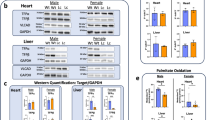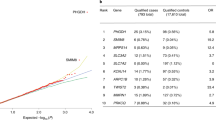Abstract
Refsum disease is an autosomal-recessively inherited disorder characterized clinically by a tetrad of abnormalities: retinitis pigmentosa, peripheral neuropathy, cerebellar ataxia and elevated protein levels in the cerebrospinal fluid (CSF) without an increase in the number of cells in the CSF. All patients exhibit accumulation of an unusual branched-chain fatty acid, phytanic acid (3,7,11,15-tetramethylhexadecanoic acid), in blood and tissues. Biochemically, the disease is caused by the deficiency of phytanoyl-CoA hydroxylase (PhyH), a peroxisomal protein catalyzing the first step in the α-oxidation of phytanic acid. We have purified PhyH from rat-liver peroxisomes and determined the N-terminal amino-acid sequence, as well as an additional internal amino-acid sequence obtained after Lys-C digestion of the purified protein. A search of the EST database with these partial amino-acid sequences led to the identification of the full-length human cDNA sequence encoding PhyH: the open reading frame encodes a 41.2-kD protein of 338 amino acids, which contains a cleavable peroxisomal targeting signal type 2 (PTS2). Sequence analysis of PHYH fibroblast cDNA from five patients with Refsum disease revealed distinct mutations, including a one-nucleotide deletion, a 111-nucleotide deletion and a point mutation. This analysis confirms our finding that Refsum disease is caused by a deficiency of PhyH.
This is a preview of subscription content, access via your institution
Access options
Subscribe to this journal
Receive 12 print issues and online access
$209.00 per year
only $17.42 per issue
Buy this article
- Purchase on Springer Link
- Instant access to full article PDF
Prices may be subject to local taxes which are calculated during checkout
Similar content being viewed by others
References
Refsum, S. Heredopathia atactica polyneuritiformis. Acta Psychiatr. Scand. (Suppl.) 38, 9–303 (1946).
Steinberg, D. Refsum disease, in The Metabolic and Molecular Basis of Inherited Disease, 7th ed. (eds Scriver, C.R., Beaudet, A.L, Sly, W.S. & Valle, D.) 2351–2369 (McGraw-Hill, New York, 1995).
Skjeldal, O.H., Stokke, O., Refsum, S., Norseth, J. & Petit, H. Clinical and biochemical heterogeneity in conditions with phytanic acid accumulation. J. Neurol. Sci. 77, 87–96 (1987).
Mihalik, S.J., Rainville, A.M. & Watkins, P.A. Phytanic acid α-oxidation in rat liver peroxisomes: production of α-hydroxyphytanoyl-CoA and formate is enhanced by dioxygenase cofactors. Eur. J. Biochem. 232, 545–551 (1995).
Jansen, G.A. et al. Phytanoyl-CoA hydroxylase is present in human liver, located in peroxisomes and deficient in Zellweger syndrome: direct, unequivocal evidence for the new, revised pathway of phytanic acid a-oxidation in humans. Biochem. Biophys. Res. Commun. 229, 205–210 (1996).
Croes, K., Casteels, M., De Hoffmann, E., Mannaerts, G.P. & Van Veldhoven, P.P. α-Oxidation of 3-methyl-substituted fatty acids in rat liver: production of formic acid instead of CO2, cofactor requirements, subcellular localization and formation of a 2-hydroxy-3-methylacyl-CoA intermediate. Eur. J. Biochem. 240, 674–683 (1996).
Jansen, G.A. et al. Phytanoyl-CoA hydroxylase is not only deficient in classical Refsum disease but also in rhizomelic chondrodysplasia punctata. J. Inherited Metab. Dis. 20, 444–446 (1997).
Jansen, G.A., Wanders, R.J.A., Watkins, P.A. & Mihalik, S.J. Phytanoyl–coenzyme A hydroxylase deficiency—the enzyme defect in Refsum's disease. N. Engl. J. Med. 337, 133–134 (1997).
Lazarow, P.B. & Moser, H.W. Disorders of peroxisome biogenesis, in The Metabolic and Molecular Basis of Inherited Disease, 7th ed. (eds Scriver, C.R., Beaudet, A.L., Sly, W.S. & Valle, D.) 2287–2324 (McGraw-Hill, New York, 1995).
Motley, A.M. et al. Rhizomelic chondrodysplasia punctata is a peroxisomal protein targeting disease caused by a non-functional PTS2 receptor. Nature Genet. 15, 377–380 (1997).
Purdue, P.E., Zhang, J.W., Skoneczny, M. & Lazarow, P.B. Rhizomelic chondrodysplasia punctata is caused by deficiency of human PEX7, a homologue of the yeast PTS2 receptor. Nature Genet. 15, 381–384 (1997).
Braverman, N. et al. Human PEX7 encodes the peroxisomal PTS2 receptor and is responsible for rhizomelic chondrodysplasia punctata. Nature Genet. 15, 369–375 (1997).
Waterham, H.R. & Cregg, J.M. Peroxisome biogenesis. Bioessays 19, 57–66 (1997).
Subramani, S. S. PEXgenes on the rise. Nature Genet. 15, 331–333 (1997).
Purdue, P.E. & Lazarow, P.B. Peroxisomal biogenesis: multiple pathways of protein import. J Biol. Chem. 269, 30065–30068 (1994).
Altschul, S.F., Gish, W., Miller, W., Myers, E.W. & Lipman, D.J. Basic local alignment search tool. J. Mol. Biol. 215, 403–410 (1990).
Kozak, M. Compilation and analysis of sequences upstream from the translational start site in eukaryotic mRNAs. Nucleic Acids Res. 12, 857–872 (1984).
Swinkels, B.W., Gould, S.J., Bodnar, A.G., Rachubinski, R.A. & Subramani, S. A novel, cleavable peroxisomal targeting signal at the amino-terminus of the rat 3-ketoacyl-CoAthiolase. EMBO J. 10, 3255–3262 (1991).
De Vet, E.C.J.M., Zomer, A.W.M., Lahaut, G.J.H.T.J., & van den Bosch, H. Polymerase chain reaction-based cloning of alkyl-dihydroxyacetonephosphate synthase complementary DNA from guinea pig liver. J. Biol. Chem. 272, 798–803 (1997).
Osumi, T. et al. Amino-terminal presequence of the precursor of peroxisomal 3-ketoacyl-CoA thiolase is a cleavable signal peptide for peroxisomal targeting. Biochem. Biophys. Res. Commun. 181, 947–954 (1991).
Krawczak, M., Reiss, J. & Cooper, D.N. The mutational spectrum of single base-pair substitutions in mRNA splice junctions of human genes: causes and consequences. Hum. Genet. 90, 41–54 (1992).
Ljlst, L., Wanders, R.J.A., Ushikubo, S., Kamijo, T., & Hashimoto, T. Molecular basis of long-chain 3-hydroxyacyl-CoA dehydrogenase deficiency: identification of the major disease-causing mutation in the α-subunit of the mitochondria! trifunctional protein. Biochim. Biophys. Acta. 1215, 347–350 (1994).
Author information
Authors and Affiliations
Rights and permissions
About this article
Cite this article
Jansen, G., Oftnan, R., Ferdinandusse, S. et al. Refsum disease is caused by mutations in the phytanoyl–CoA hydroxylase gene. Nat Genet 17, 190–193 (1997). https://doi.org/10.1038/ng1097-190
Received:
Accepted:
Issue Date:
DOI: https://doi.org/10.1038/ng1097-190
This article is cited by
-
Ichthyosis
Nature Reviews Disease Primers (2023)
-
Ausgeprägte Bandkeratopathie bei Refsum-Syndrom
Die Ophthalmologie (2022)
-
Naturally occurring 3RS, 7R, 11R-phytanic acid suppresses in vitro T-cell production of interferon-gamma
Lipids in Health and Disease (2018)
-
Systematic review of autosomal recessive ataxias and proposal for a classification
Cerebellum & Ataxias (2017)
-
Proteomic signature of muscle fibre hyperplasia in response to faba bean intake in grass carp
Scientific Reports (2017)



